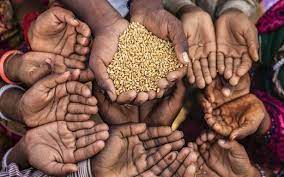- Books Name
- Learn with me Social Science Book
- Publication
- Learn with me publication
- Course
- CBSE Class 9
- Subject
- Social Science
Food Security in India
Food security means availability, accessibility and affordability of food to all people at all times.
Availability: Food production in the country, import of food
Accessibility: Food within the reach of every person
Affordability: To have enough money to buy sufficient amount of food.
Food security
The poorest section of the society remains food insecure all the times. People above poverty line might also feel food insecure in times of natural calamity like earthquake, drought, flood, tsunami, etc.
Natural calamities may lead to starvation. Starvation in longer run turns into famine.

A famine is characterised by wide spread deaths due to starvation and epidemics caused by forced use of contaminated water or decaying water or decaying food and loss of body resistance due to weakening from starvation.
Food-insecure in rural areas, the worst affected people are: landless and small farmers, traditional artisans (weavers, potters, blacksmith etc.) providers of services(e.g. barbers, washer men etc), petty self-employed workers and destitute. In the urban areas, persons employed in ill-paid occupations and casual labourers are food insecure.
The social composition also plays a role in food insecurity. The SCs, STs and some sections of OBC ( lower castes) who are landless or with low land productivity are prone to be food insecure.
Large proportion of pregnant and nursing mothers and children under the age of 5 years constitute an important segment of the food insecure population.
- Hunger: Hunger has chronic and seasonal dimensions. Poor people suffer from chronic hunger and are food insecure all the times. Seasonal hunger is caused by the seasonal nature of agricultural activities in rural areas. In urban areas, seasonal hunger occurs because of the casual type of work. Thus, seasonal hunger exists when people are unable to get work for the whole year.
Need for self-sufficiency in food grains.
- Our government since Independence realised the need to attain self-sufficiency in food grains because India experienced acute shortage of food grains after partition of the country in 1947.
The need for self-sufficiency arises from the following:
(a) to feed rising population
(b) to fight against droughts, floods, cyclone, etc.
(c) to reduce import of food grains
(d) to control prices of food grains.
- Food Security System in India. Since the advent of the Green Revolution in the 1960s the country has avoided famine, even during adverse weather conditions.
- Punjab and Hryan has shown very impressive growth in food production with 7.23 million tonnes in 1964-65 to a record 218 milion tonnes in 2009-10.
- India has become self–sufficient in food grains during the last 30 years because of the variety of crops grown all over the country. Also, we have developed a food security system.
- Still a few states have lagged behind in food production.e.g. Orissa.
Buffer Stock: Buffer stock is the stock of food grains (wheat and rice) procured by the government through the Food Corporation of India (FCI). The FCI purchases wheat and rice for the government from the farmers of surplus states at pre-announced prices. This price is called ‘minimum support price’.
The food is distributed to the poorer strata of society at lower price than market place is known as Issue price.

 Learn with me publication
Learn with me publication
